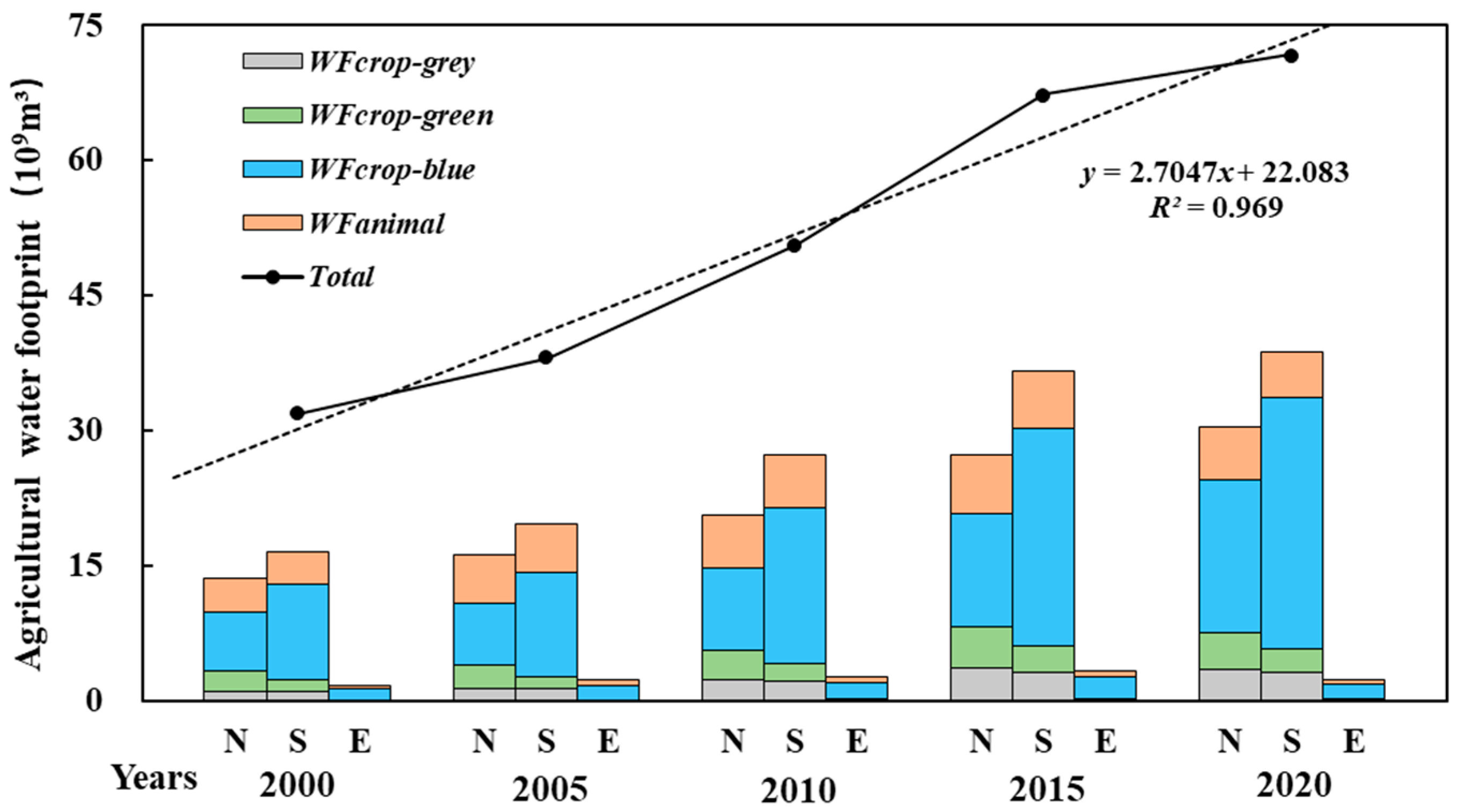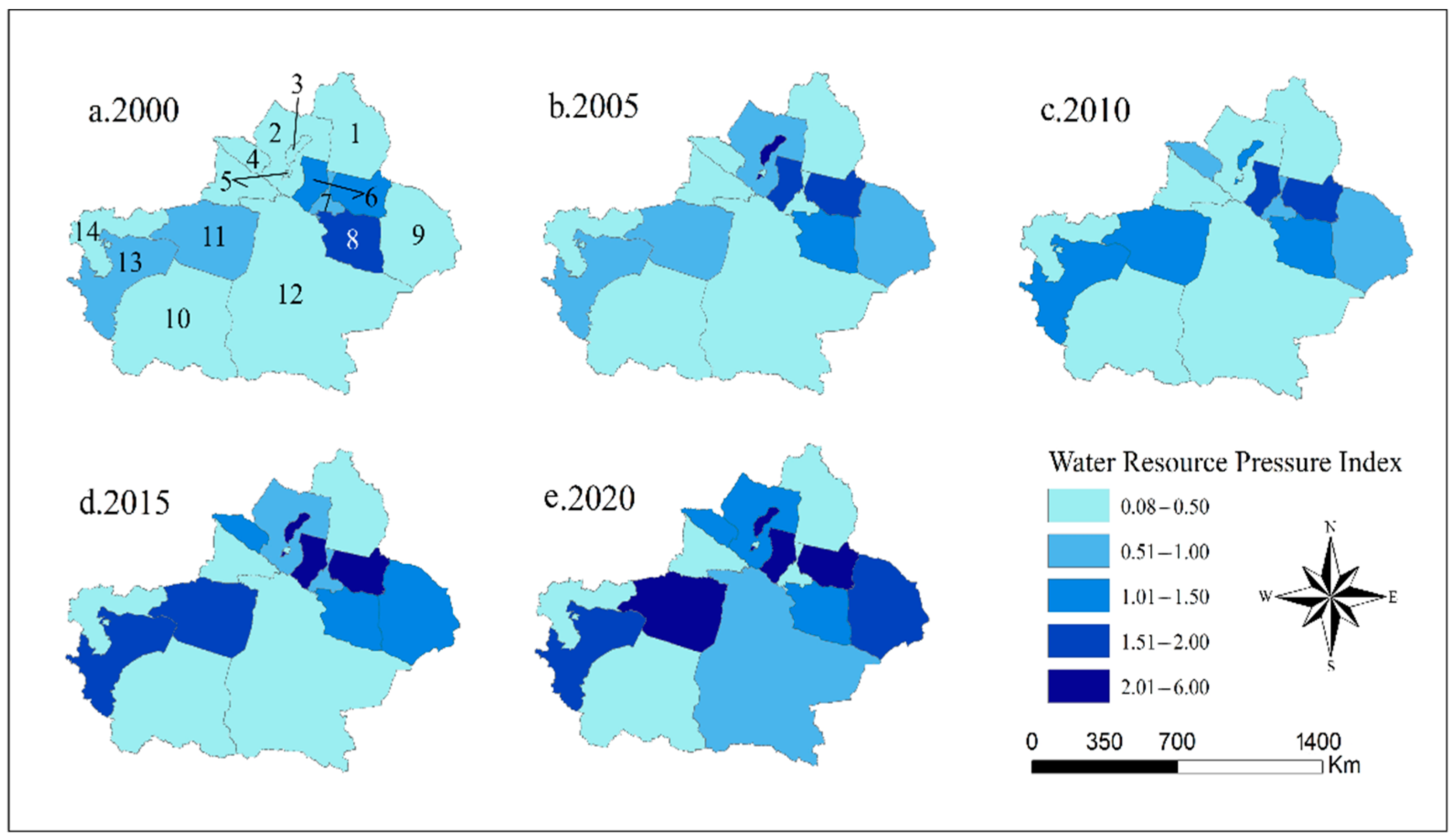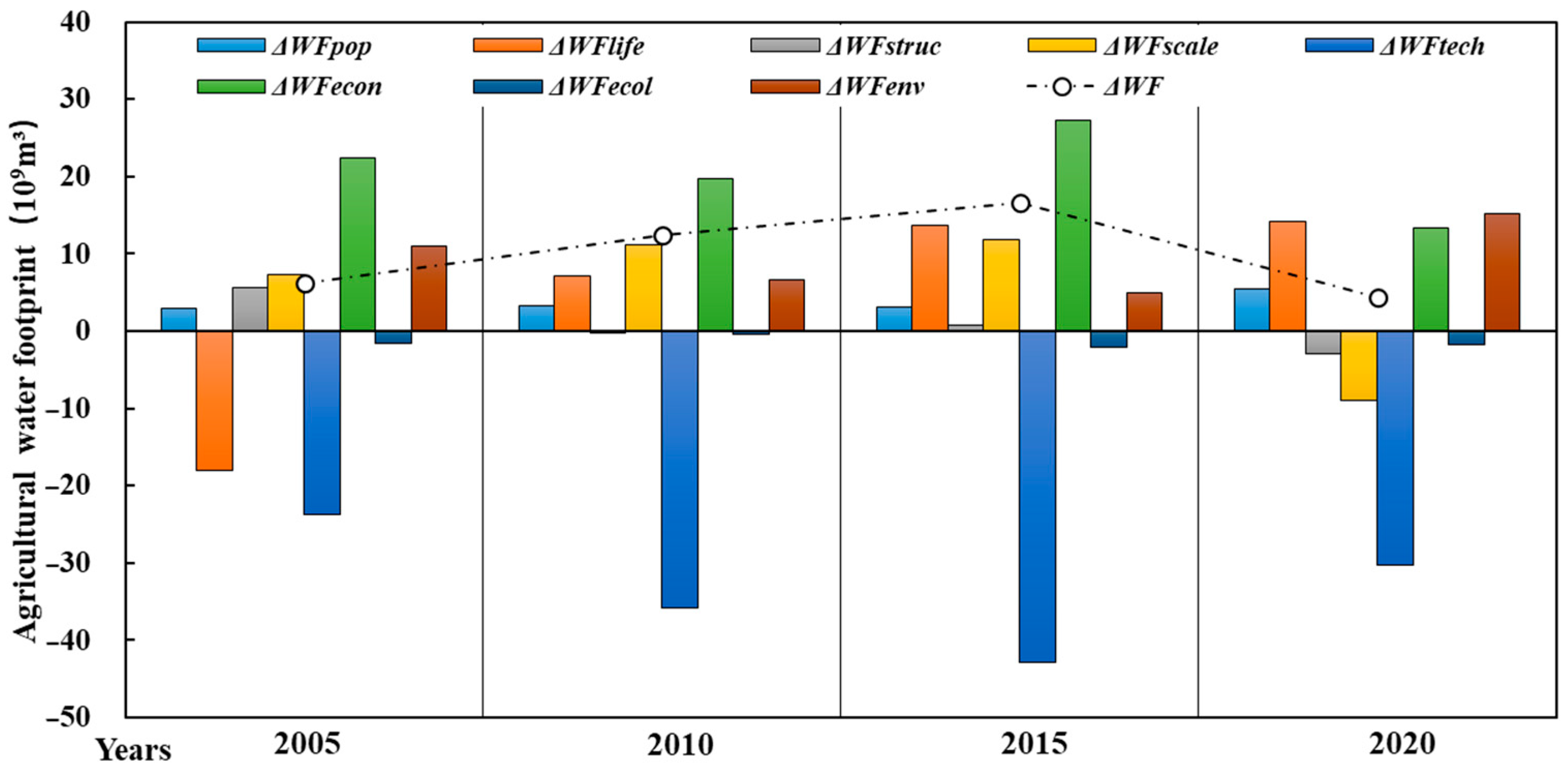Unveiling the Dynamics and Influence of Water Footprints in Arid Areas: A Case Study of Xinjiang, China
Abstract
:1. Introduction
2. Study Area, Data, and Methodology
2.1. Study Site Description
2.2. Meteorological, Water Resource, and Statistical Data Sources
2.3. Methodology
2.3.1. Agricultural Water Footprint
- (1)
- Crop Water Footprint
- (2)
- Animal Water Footprint
2.3.2. Water Resource Pressure Assessment Index
2.3.3. Exploratory Spatial Data Analysis
2.3.4. Logarithmic Mean Divisia Index
2.3.5. Geographical Detector
3. Results
3.1. Temporal Evolution Analysis of the Agricultural Water Footprint
3.2. Spatio-Temporal Evolution Analysis of Water Resource Pressure
3.3. Spatial Correlation Analysis of Water Resource Pressure
3.3.1. Global Spatial Autocorrelation Analysis of Water Resource Pressure in XJ
3.3.2. Local Spatial Autocorrelation Analysis of Water Resource Pressure in XJ
3.4. Analysis of Factors Influencing the Evolution of the Production Water Footprint and Water Resource Pressure
3.4.1. Contribution Value of the Agricultural Water Footprint’s Driving Factors in XJ
3.4.2. Intensity of Factors Influencing Water Resource Pressure in XJ
4. Discussion
4.1. Key Factors Affecting Changes in the Agricultural Water Footprint and Water Stress and Suggestions for Addressing Them
4.2. Discussion on the Driving Mechanism of Agricultural Water Footprint and Water Resource Pressure
5. Conclusions
- (1)
- From 2000 to 2020, XJ’s agricultural water footprint was in a state of continuous growth, with the total amount more than doubling. Among the components of the agricultural water footprint, the crop water footprint increased more than the animal water footprint, and significant growth has occurred mainly in the southern and northern regions. During the study period, changes in the water stress in XJ’s cities and towns were unstable, with super-high water stress indices concentrated in the eastern XJ region, and the overall trend was upward. The spatial distribution of the water stress index was uneven, concentrated in the west and east of XJ, and the regional differences between the north and the south were smaller than those between the east and the west. Regions such as Karamay, Changji, Turpan, Aksu, and Kashgar had high multi-year average water stresses.
- (2)
- The spatial correlation of the water resource pressure index is obvious, its negative correlation is significant, and the intensity of the discrete state shows fluctuating changes. The water resource pressure HH agglomeration area is mainly concentrated in the junction zone of east XJ and north XJ, and the HL agglomeration area is mainly distributed in the western part of south XJ; however, the spatial changes in these two agglomerations were relatively small, while the changes in the LH agglomeration area were larger. During the period of 2000–2020, the state of water resource pressure agglomeration in XJ weakened, the fluctuation of the discrete state was enhanced, the number of spatially correlated prefectures decreased, the mismatch continued to increase, and the differences were gradually highlighted. Therefore, the XJ government should pay more attention to the variability in the water stress between regions to avoid increasing polarization.
- (3)
- In terms of its contribution to driving the change in the agricultural water footprint in XJ, the total effect of each factor was always positive during the period of 2005–2020, but the effect value generally showed a downward trend. Among them, 2015 was the turning point for the change in the trend in the total effect value, in which the technological effect (water consumption of CNY 10,000 GDP), the economic effect (GDP per capita), and the environmental effect (total carbon emission of CO2) had the most significant impact on the evolution of the agricultural water footprint in XJ. Therefore, the government should formulate policies to encourage the innovation and development of agriculture-related technologies. In this way, it can promote the suppression of technological effects on the agricultural water footprint, thereby reducing water stress in XJ. The intensity of the effect of different factors on the spatial differentiation of the water stress index in XJ was not the same in different time periods. The spatial differentiation of water resources in XJ has mainly been determined by the expansion of its irrigation scale (cultivated area), the growth of its population (total population), the imbalance of its industrial structure (share of agricultural water use), and the evolution of the area of natural oases.
Author Contributions
Funding
Data Availability Statement
Conflicts of Interest
References
- Zarei, Z.; Karami, E.; Keshavarz, M. Co-production of knowledge and adaptation to water scarcity in developing countries. J. Environ. Manag. 2020, 262, 110283. [Google Scholar] [CrossRef] [PubMed]
- Zhang, L.; Yu, Y.; Ireneusz, M.; Malgorzata, W.; Sun, L.; Yang, M.; Wang, Q.; Yu, D. Water Resources Evaluation in Arid Areas Based on Agricultural Water Footprint—A Case Study on the Edge of the Taklimakan Desert. Atmosphere 2022, 14, 67. [Google Scholar] [CrossRef]
- Feng, K.; Hubacek, K.; Pfister, S.; Yu, Y.; Sun, L. Virtual scarce water in China. Environ. Sci. Technol. 2014, 48, 7704–7713. [Google Scholar] [CrossRef] [PubMed]
- Jiao, L. Food security. Water shortages loom as northern China’s aquifers are sucked dry. Science 2010, 328, 1462–1463. [Google Scholar] [CrossRef] [PubMed]
- Piao, S.; Fang, J.; Zhou, L.; Ciais, P.; Zhu, B. Variations in satellite-derived phenology in China’s temperate vegetation. Glob. Chang. Biol. 2006, 12, 672–685. [Google Scholar] [CrossRef]
- Dai, Y.Y. Quantitative Evaluation of Generalized Water Resources in Changing Environment Based on Water Cycle Simulation. Master’s Thesis, China University of Mining and Technology, Xuzhou, China, 2019. [Google Scholar]
- Falkenmark, M.; Widstrand, C. Population and water resources: A delicate balance. Popul. Bull. 1992, 47, 1–36. [Google Scholar] [CrossRef] [PubMed]
- Gabriela, A.; Antonio, M.M.; Edson, T. Assessing sectoral water stress states from the demand-side perspective through water footprint dimensions decomposition. Sci. Total Environ. 2021, 809, 152216. [Google Scholar] [CrossRef]
- Liu, X.; Du, H.; Zhang, X.; Feng, K.; Zhao, X.; Zhong, H.; Zhang, N.; Chen, Z. Assessing Transboundary Impacts of Energy-Driven Water Footprint on Scarce Water Resources in China: Catchments under Stress and Mitigation Options. Environ. Sci. Technol. 2023, 57, 9639–9652. [Google Scholar] [CrossRef]
- Pfister, S.; Koehler, A.; Hellweg, S. Assessing the environmental impacts of freshwater consumption in LCA. Environ. Sci. Technol. 2009, 43, 4098–4104. [Google Scholar] [CrossRef]
- Gai, L.; Xie, G.; Li, S.; Cheng, Y.; Luo, Z. The Analysis of Water Footprint of Production and Water Stress in China. J. Resour. Ecol. 2016, 7, 334–341. [Google Scholar] [CrossRef]
- Zeng, Z.; Liu, J.; Savenije, H.H.G. A simple approach to assess water scarcity integrating water quantity and quality. Ecol. Indic. 2013, 34, 441–449. [Google Scholar] [CrossRef]
- Jia, X.; Yan, Y.; Zhu, C.; Bai, X.; Hu, M.; Wu, G. Approaches for Regional Water Resources Stress Assessment: A Review. J. Nat. Resour. 2016, 31, 1783–1791. [Google Scholar] [CrossRef]
- Zeng, D.; Wang, J.; Li, Y.; Jiang, J.; Lv, L. Spatial-temporal Variation of Water Resources Stress and Its Influencing Factors Based on Water-saving in China. Sci. Geogr. Sin. 2021, 41, 157–166. [Google Scholar] [CrossRef]
- Sun, S.; Wu, P.; Wang, Y.; Zhao, X.; Liu, J.; Zhang, X. The impacts of interannual climate variability and agricultural inputs on water footprint of crop production in an irrigation district of China. Sci. Total Environ. 2013, 444, 498–507. [Google Scholar] [CrossRef] [PubMed]
- Zhao, X.; Zhao, J.; Ma, C.; Xiao, L.; Ma, C.; Wang, X. Study of resource-environmental pressure considering the Footprint Family in Yunnan Province, China. Acta Ecol. Sin. 2016, 36, 3714–3722. [Google Scholar] [CrossRef]
- Chapagain, A.K.; Hoekstra, A.Y. The blue, green and grey water footprint of rice from production and consumption perspectives. Ecol. Econ. 2011, 70, 749–758. [Google Scholar] [CrossRef]
- Fan, L.; Wang, H.; Liu, C.; Sui, G. Vulnerability assessment of water resources based on pressure-state-response model in Xinjiang. South-To-North Water Transf. Water Sci. Technol. 2022, 20, 1052–1064. [Google Scholar] [CrossRef]
- Zhang, L.; Deng, X.; Long, A.; Gao, H.; Ren, C.; Li, Z. Spatia-temporal assessment of water resource security based on the agricultural water footprint: A case in the Hotan Prefecture of Xinjiang. Arid Zone Res. 2022, 39, 436–447. [Google Scholar] [CrossRef]
- Feng, Z.H. Research on the Evaluation of Agricultural Sustainable Development in Northwest China Based on Water Resources Carrying Capacity. Ph.D. Thesis, Xi’an University of Technology, Xi’an, China, 2021. [Google Scholar]
- Yao, J.; Zhao, Y.; Chen, Y.; Yu, X.; Zhang, R. Multi-scale assessments of droughts: A case study in Xinjiang, China. Sci. Total Environ. 2018, 630, 444–452. [Google Scholar] [CrossRef]
- Hai, Y.; Long, A.; Zhang, P.; Deng, X.; Li, J.; Deng, M. Evaluating agricultural water-use efficiency based on water footprint of crop values: A case study in Xinjiang of China. J. Arid Land 2020, 12, 580–593. [Google Scholar] [CrossRef]
- Zhang, Q.; Sun, P.; Li, J.; Singh Vijay, P.; Liu, J. Spatiotemporal properties of droughts and related impacts on agriculture in Xinjiang, China. Int. J. Climatol. 2015, 35, 1254–1266. [Google Scholar] [CrossRef]
- Xiniiang Uygur Autonomous Region Statistics Bureau. Xinjiang Statistical Yearbook; China Statistics Press: Beijing, China, 2020. [Google Scholar]
- Hoekstra, A.Y. Water Footprint Assessment: Evolvement of a New Research Field. Water Resour. Manag. 2017, 31, 3061–3081. [Google Scholar] [CrossRef]
- Yu, J.; Long, A.; Deng, X.; He, X.; Zhang, P.; Wang, J.; Hai, Y. Incorporating the red jujube water footprint and economic water productivity into sustainable integrated management policy. J. Environ. Manag. 2020, 269, 110828. [Google Scholar] [CrossRef]
- Hoekstra, A.Y.; Chapagain, A.K.; Aldaya, M.M.; Hoekstra, M.M.M. The Water Footprint Assessment Manual: Setting the Global Standard; Routledge: London, UK, 2011. [Google Scholar]
- Cui, S.; Dong, H.; Wilson, J. Grey water footprint evaluation and driving force analysis of eight economic regions in China. Environ. Sci. Pollut. Res. Int. 2020, 27, 20380–20391. [Google Scholar] [CrossRef] [PubMed]
- Zhang, P.; Deng, M.; Long, A.; Deng, X.; Wang, H.; Hai, Y.; Wang, J.; Liu, Y. Coupling analysis of social-economic water consumption and its effects on the arid environments in Xinjiang of China based on the water and ecological footprints. J. Arid Land 2020, 12, 73–89. [Google Scholar] [CrossRef]
- Chapagain, A.K.; Hoekstra, A.Y. Virtual Water Flows between Nations in Relation to Trade in Livestock and Livestock Products; IHE Delft: Delft, The Netherlands, 2003. [Google Scholar]
- Shekhar, S.; Xiong, H.; Zhou, X. Encyclopedia of GIS; Springer: Cham, Switzerland, 2017. [Google Scholar]
- Qin, W.; Wang, L.; Xu, L.; Sun, L.; Li, J.; Zhang, J.; Shao, H. An exploratory spatial analysis of overweight and obesity among children and adolescents in Shandong, China. BMJ Open 2019, 9, e028152. [Google Scholar] [CrossRef] [PubMed]
- Cheniti, H.; Cheniti, M.; Brahamia, K. Use of GIS and Moran’s I to support residential solid waste recycling in the city of Annaba, Algeria. Environ. Sci. Pollut. Res. Int. 2021, 28, 34027–34041. [Google Scholar] [CrossRef]
- Ang, B.W. Decomposition analysis for policymaking in energy: Which is the preferred method? Energy Policy 2004, 32, 1131–1139. [Google Scholar] [CrossRef]
- Ang, B.W.; Xu, X.Y.; Su, B. Multi-country comparisons of energy performance: The index decomposition analysis approach. Energy Econ. 2015, 47, 68–76. [Google Scholar] [CrossRef]
- Papagiannaki, K.; Diakoulaki, D. Decomposition analysis of CO2 emissions from passenger cars: The cases of Greece and Denmark. Energy Policy 2009, 37, 3259–3267. [Google Scholar] [CrossRef]
- Zhao, C.; Chen, B. Driving Force Analysis of the Agricultural Water Footprint in China Based on the LMDI Method. Environ. Sci. 2014, 48, 12723–12731. [Google Scholar] [CrossRef]
- Wang, G.; Peng, W. Quantifying spatiotemporal dynamics of vegetation and its differentiation mechanism based on geographical detector. Environ. Sci. Pollut. Res. Int. 2022, 29, 32016–32031. [Google Scholar] [CrossRef] [PubMed]
- Gong, B.; Liu, Z. Assessing impacts of land use policies on environmental sustainability of oasis landscapes with scenario analysis: The case of northern China. Landsc. Ecol. 2020, 36, 1913–1932. [Google Scholar] [CrossRef]
- Balasubramaniam, T.; Shen, G.; Esmaeili, N.; Zhang, H. Plants’ Response Mechanisms to Salinity Stress. Plants 2023, 12, 2253. [Google Scholar] [CrossRef]
- Zhang, Z.; Xia, F.; Yang, D.; Huo, J.; Wang, G.; Chen, H. Spatiotemporal characteristics in ecosystem service value and its interaction with human activities in Xinjiang, China. Ecol. Indic. 2020, 110, 105826. [Google Scholar] [CrossRef]
- Wang, Y.; Zhang, S.; Zhen, H.; Chang, X.; Shataer, R.; Li, Z. Spatiotemporal Evolution Characteristics in Ecosystem Service Values Based on Land Use/Cover Change in the Tarim River Basin, China. Sustainability 2020, 12, 7759. [Google Scholar] [CrossRef]
- Zhang, P.; Deng, X.; Long, A.; Hai, Y.; Li, Y.; Wang, H.; Xu, H. Impact of Social Factors in Agricultural Production on the Crop Water Footprint in Xinjiang, China. Water 2018, 10, 1145. [Google Scholar] [CrossRef]
- Mekonnen, M.M.; Hoekstra, A.Y. Water footprint benchmarks for crop production: A first global assessment. Ecol. Indic. 2014, 46, 214–223. [Google Scholar] [CrossRef]
- Wang, Y.; Long, A.; Xiang, L.; Deng, X.; Zhang, P.; Hai, Y.; Wang, J.; Li, Y. The verification of Jevons’ paradox of agricultural Water conservation in Tianshan District of China based on Water footprint. Agric. Water Manag. 2020, 239, 106163. [Google Scholar] [CrossRef]
- Long, A.; Yu, J.; Deng, X.; He, X.; Du, J. Understanding the Spatial-Temporal Changes of Oasis Farmland in the Tarim River Basin from the Perspective of Agricultural Water Footprint. Water 2021, 13, 696. [Google Scholar] [CrossRef]
- Gao, D.; Long, A.; Yu, J.; Xu, H.; Zhao, X. Assessment of Inter-Sectoral Virtual Water Reallocation and Linkages in the Northern Tianshan Mountains, China. Water 2020, 12, 2363. [Google Scholar] [CrossRef]
- Vanham, D.H.; Hoekstra, A.Y.; Wada, Y.; Bouraoui, F.; de Roo, A.; Mekonnen, M.M.; van de Bund, W.J.; Batelaan, O.; Pavelic, P.; Bastiaanssen, W.G.M.; et al. Physical water scarcity metrics for monitoring progress towards SDG target 6.4: An evaluation of indicator 6.4.2 “Level of water stress”. Sci. Total Environ. 2018, 613–614, 218–232. [Google Scholar] [CrossRef] [PubMed]
- Pu, C.; Quan, L. Reflections on the Development of the West and the Anti-Poverty Problem in Xinjiang. J. Xinjiang Univ. Financ. Econ. 2000, 4, 5–6. [Google Scholar]
- Long, A.; Zhang, P.; Hai, Y.; Deng, X.; Wang, J. Spatio-Temporal Variations of Crop Water Footprint and Its Influencing Factors in Xinjiang, China during 1988–2017. Sustainability 2020, 12, 9678. [Google Scholar] [CrossRef]





| Year | X1 | X2 | X3 | X4 | X5 | X6 | X7 | X8 |
|---|---|---|---|---|---|---|---|---|
| 2000 | 0.619 | 0.232 | 0.577 | 0.665 | 0.282 | 0.223 | 0.566 | 0.473 |
| 2005 | 0.641 | 0.559 | 0.599 | 0.634 | 0.550 | 0.385 | 0.616 | 0.387 |
| 2010 | 0.527 | 0.614 | 0.564 | 0.663 | 0.406 | 0.252 | 0.503 | 0.569 |
| 2015 | 0.517 | 0.601 | 0.600 | 0.664 | 0.411 | 0.406 | 0.626 | 0.356 |
Disclaimer/Publisher’s Note: The statements, opinions and data contained in all publications are solely those of the individual author(s) and contributor(s) and not of MDPI and/or the editor(s). MDPI and/or the editor(s) disclaim responsibility for any injury to people or property resulting from any ideas, methods, instructions or products referred to in the content. |
© 2024 by the authors. Licensee MDPI, Basel, Switzerland. This article is an open access article distributed under the terms and conditions of the Creative Commons Attribution (CC BY) license (https://creativecommons.org/licenses/by/4.0/).
Share and Cite
Ren, C.; Zhang, P.; Deng, X.; Zhang, J.; Wang, Y.; Wang, S.; Yu, J.; Lai, X.; Long, A. Unveiling the Dynamics and Influence of Water Footprints in Arid Areas: A Case Study of Xinjiang, China. Water 2024, 16, 1164. https://doi.org/10.3390/w16081164
Ren C, Zhang P, Deng X, Zhang J, Wang Y, Wang S, Yu J, Lai X, Long A. Unveiling the Dynamics and Influence of Water Footprints in Arid Areas: A Case Study of Xinjiang, China. Water. 2024; 16(8):1164. https://doi.org/10.3390/w16081164
Chicago/Turabian StyleRen, Cai, Pei Zhang, Xiaoya Deng, Ji Zhang, Yanyun Wang, Shuhong Wang, Jiawen Yu, Xiaoying Lai, and Aihua Long. 2024. "Unveiling the Dynamics and Influence of Water Footprints in Arid Areas: A Case Study of Xinjiang, China" Water 16, no. 8: 1164. https://doi.org/10.3390/w16081164





